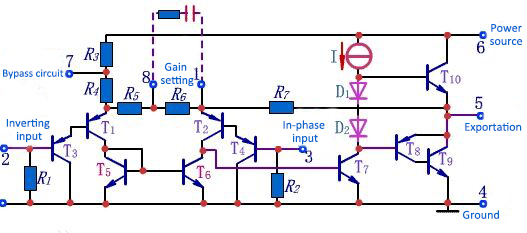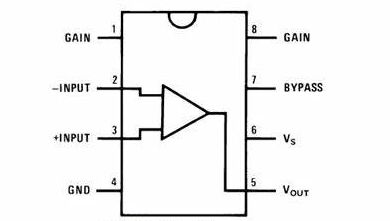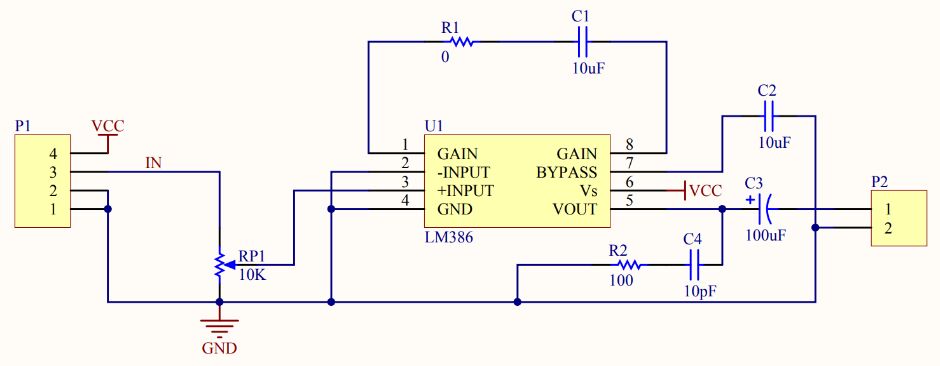By Audio Amplifier Circuit 168
LM386 is a commonly used low-power audio amplifier integrated circuit, usually used to amplify audio signals. LM386 is an audio integrated power amplifier with the advantages of low power consumption, adjustable internal chain gain, wide power supply voltage range, few external components and low total harmonic distortion. It is widely used in recorders and radios.
LM386 has the following features:
•Adjustable amplification: The amplification of LM386 can be adjusted through external resistors and capacitors to meet different audio amplification needs.
•Low power consumption: The LM386 usually operates on a low voltage power supply, making it suitable for portable electronic equipment.
•Single-supply operation: The LM386 can be powered from a single power supply, typically in the 6V to 12V range, making it easy to integrate into a variety of circuits.
•Stability: The LM386 is internally stable and usually does not require external compensation circuitry.
•Built-in input and output capacitors: The input and output pins of LM386 have built-in capacitors to simplify circuit design.
• Protection function over temperature and power range.
Ⅰ.Electrical parameters of LM386
1.Limit parameters
•Power supply voltage:15V
•Package dissipation:1.25W
•Input voltage:±0.4V
•Storage temperature:-65℃ to +150℃
•Operating temperature: 0℃ to +70℃
•Junction temperature:+150℃
2.Welding information
•Welding (10s):260℃
•Small Outline Packages:SOIC and MSOP
•Gas phase (60s):215℃
•Infrared (15s):220℃
3.Electrical characteristics

Ⅱ.Internal circuit and pin layout of LM386
1.Internal circuit

•The first stage is a differential amplification circuit. T1, T3, T2 and T4 respectively form a composite tube, which serves as the amplifier tube of the differential amplification circuit; T5 and T6 form a mirror current source as the active load of T1 and T2; the signals of T3 and T4 are from The base input of the tube is output from the collector of the T2 tube, which is a double-ended input single-ended output differential circuit. Using the mirror current source as the active load of the differential amplifier circuit can make the gain of the single-ended output circuit approximately equal to the gain of the double-ended output capacitor.
•The second stage is a common emitter amplifier circuit, T7 is an amplifier tube, and the constant current source is used as an active load to increase the amplification factor.
•The T8 and T9 tubes in the third stage are combined into a PNP tube, and form a quasi-complementary output stage with the NPN tube T10. Diodes D1 and D2 provide the appropriate bias voltage for the output stage, which can eliminate crossover distortion.
•Resistor R7 is connected from the output end to the emitter of T2 to form a feedback path, and forms a feedback network with R5 and R6, thereby introducing deep voltage series negative feedback and giving the entire circuit a stable voltage gain.
2.Pin layout
•Pin 2 is the inverting input terminal
•Pin 3 is the non-inverting input pin
•Pin 5 is the output terminal
•Pins 6 and 4 are power and ground respectively
•Pins 1 and 8 are voltage gain setting terminals
•A bypass capacitor is connected between pin 7 and ground, usually 10p F

Ⅲ.Principle of LM386
1.The principle of LM386 is to amplify the sound signal to audible sound level. It uses an NPN transistor as the main amplifier, so its output is unipolar, that is, it only has positive polarity output. LM386 consists of power supply voltage port, feedback circuit, main amplifier and output circuit.
2.The power supply voltage used by LM386 is low voltage, has good power supply voltage suppression capability, and can be powered by batteries. Generally, a 9V battery is used for power supply. If greater output power is required, two 9V batteries can be connected in parallel or other higher voltage power supplies can be used.
3.In the feedback circuit, the output signal of the amplifier is fed back to the input terminal through resistor R2 to control the amplification factor. In the output circuit, the output of the main amplifier is connected to the electrolytic capacitor C2, the other end of the capacitor is connected to the positive electrode of the speaker, and then the negative electrode of the speaker is connected to ground.
4.The main amplifier of LM386 adopts DC coupling method, which can amplify the sound signal from low frequency to high frequency. The output capacitor C2 plays the role of DC isolation, so that the output circuit can only work through AC sound signals. DC coupling is a working method of an amplifier. In this working method, the front and rear stages of the amplifier are directly connected, without capacitors or inductors to isolate DC. The advantage of DC fusion is that it can amplify the sound signal from low frequency to high frequency, but the disadvantage is that if the static operating points of the front and rear stage circuits are not set appropriately, they may affect each other.
5.The main function of the DC blocking capacitor in the circuit is to isolate DC current. In an AC amplifier, the audio signal is an AC signal, and the capacitor has no hindrance to it. For dry DC signals, since the anode reactance of the capacitor is infinite, the DC current cannot pass through the capacitor. In this way, the static operating points of the front and rear stage circuits can be effectively prevented from being affected.

Ⅳ.Application circuit of LM386

1.Potentiometer RT1 is used to adjust the volume.
2.C2 is a bypass capacitor used to reduce audio noise.
3.The filter circuit composed of R1 and C1 is used to filter and adjust the input impedance.
4.C6 and C7 are chip power supply decoupling capacitors.
5.BEEP is 8 ohm, 0.25W speaker.
6.LM386 gain pins 1 and 8 are connected to 10uF capacitors, and the gain is 200DB.
Ⅴ.Characteristics of LM386 in terms of power efficiency and power consumption
1.Power supply efficiency: In electronic equipment, efficiency usually refers to the ability of a power supply device to convert its input power into output power. High efficiency means that the power supply device does not generate excessive heat or other forms of waste when converting input power to output power. The LM386 is a common audio amplifier integrated circuit that is generally not particularly efficient. This is because when it amplifies audio signals, it will produce some internal losses, which are mainly expressed in the form of heat. Therefore, when you use LM386 for audio amplification, you need to pay attention to its heat generation problem, because it may Increase the temperature of the power supply equipment.
2.Power consumption: LM386 is an audio amplifier integrated circuit, which consumes a certain amount of power when working. Power consumption typically depends on several factors, including supply voltage, gain setting, and output load. In LM386, the specific value of power consumption can vary within a certain range. Generally speaking, its power consumption is not particularly high, but it is not particularly low either. Therefore, when designing and using the LM386, you need to consider power efficiency or battery life, and you need to pay attention to its power consumption. In practical applications, the power consumption of LM386 can be reduced by reducing the supply voltage, optimizing gain settings, and selecting appropriate output loads.
Ⅵ.Application precautions of LM386
1.Supply voltage: Make sure to limit the LM386 supply voltage within its specifications. Typically, the LM386 operates in the 6V to 12V range. Do not exceed the specified maximum supply voltage, otherwise the chip may be damaged.
2.Gain control: Adjust the gain of LM386 through external resistors and capacitors. Choose the appropriate gain level to meet your application needs. Higher gain may cause distortion, lower gain may reduce audio quality.
3.Output load: When connecting the output to a speaker or other load, make sure the impedance of the load matches the output of the LM386. If the impedances are mismatched, distortion or performance degradation may result.
4.Thermal heat dissipation: LM386 will generate a certain amount of heat during operation. Make sure its working environment has enough heat dissipation to prevent overheating from damaging the chip. Heat sinks can be used to improve heat dissipation.
5.Input protection: Consider adding an input protection circuit to the input to prevent electrostatic discharge or other power supply noise from damaging the LM386. This can include using resistors and capacitors to create an input filter.
6.Sound quality: Pay attention to the performance parameters of the LM386, such as distortion and signal-to-noise ratio. These parameters will affect the sound quality. If you need higher sound quality, consider other audio amplifiers.
Frequently Asked Questions
1.What are the advantages and disadvantages of LM386 compared with other audio amplifier chips?
The LM386 is a relatively simple chip that is easy to use and integrate into circuits. Although not the lowest power chip, the LM386's power consumption is generally relatively low, making it suitable for portable devices and battery-powered applications. The LM386's performance parameters, such as distortion and signal-to-noise ratio, may be lower compared to some other audio amplifier chips. This affects audio quality.
2.What is the amplification factor of LM386?
There are several common gain levels of LM386: 20x gain (default gain), 50x gain, and 200x gain.
3.What is LM386 used for?
The LM386 is an integrated circuit containing a low voltage audio power amplifier. It's suitable for battery-operated equipment such as radios, guitar amplifiers, and hobby electronics projects.
4.What is the difference between LM386 and 741?
The input to the 741 must be close to half the DC supply voltage. The input of the LM386 operates from its negative supply voltage, which is typically 0V (ground). The 741's maximum output current is about 20mA, so it can drive a 2000 ohm load.
5.What level of amplifier is the LM386?
700mW, mono, 5V to 18V, analog input Class AB audio amplifier.